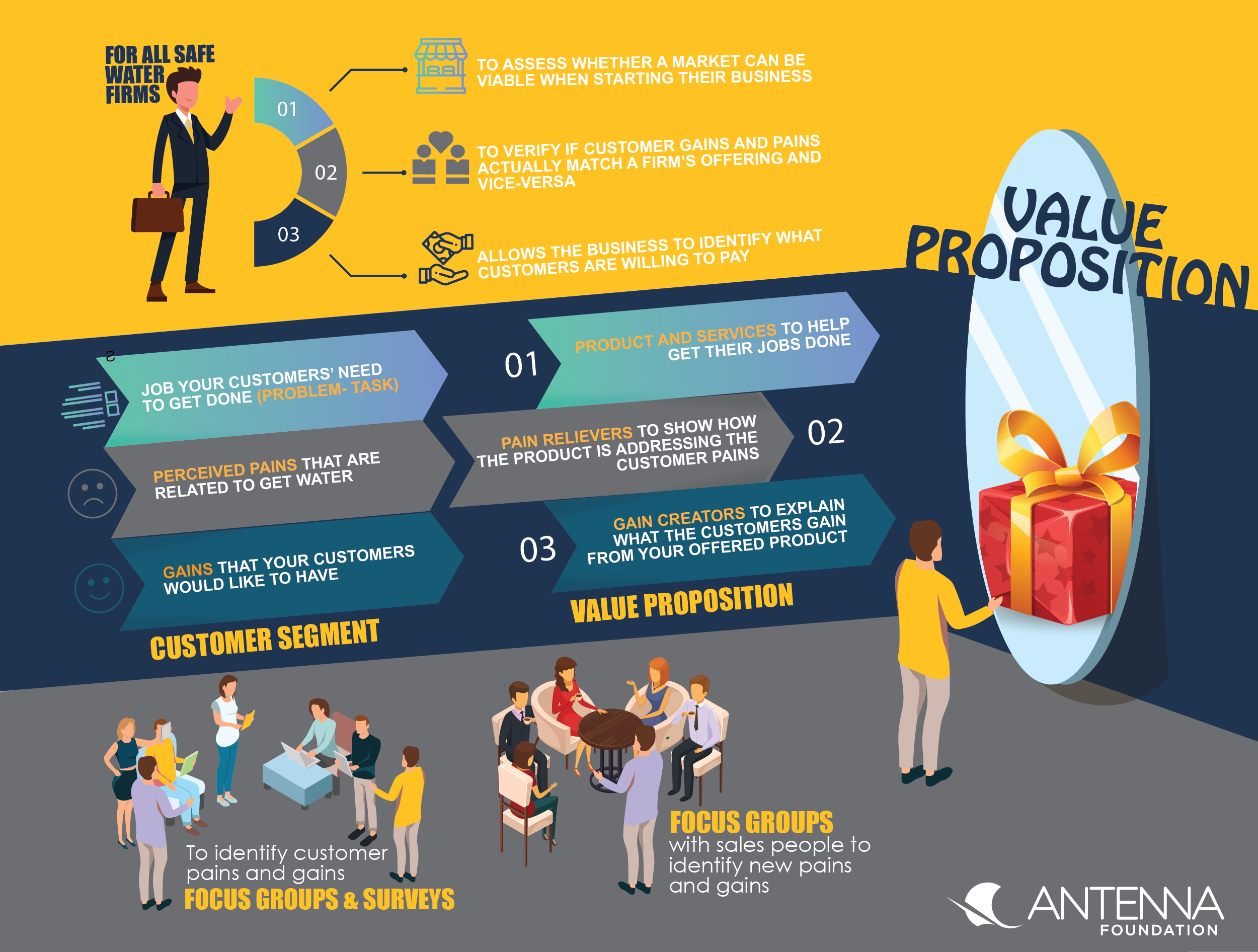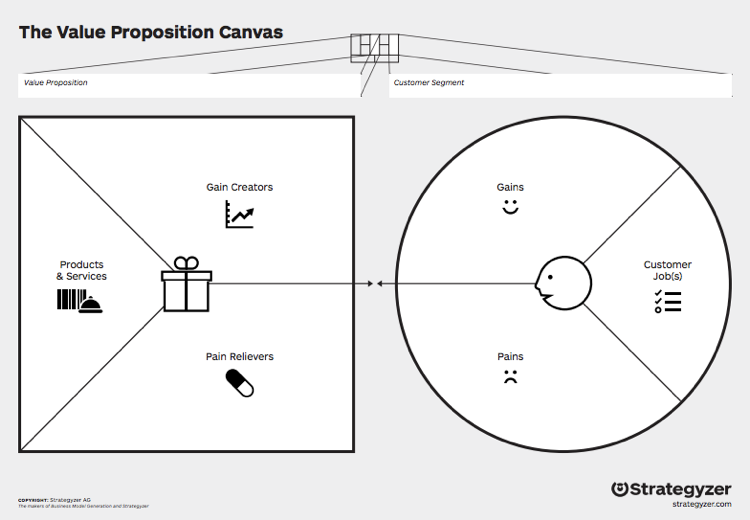Executive Summary

The value proposition represents a central element of each business model. It encompasses all parts of a product or service that generates value for the customer. In that sense, the value proposition aims to address one or multiple needs or problems of a customer group. Although most businesses start out with an idea in mind about what the customer really wants, it involves time and experiments to fully understand the role of the customer, his wants and needs, and especially how much he is willing to pay for his perceived gains. Subsequently methods are described how a safe water business can develop and shape its value proposition.
What is value proposition about?
Based on Osterwalder and Pigneurs business model concept (2014), value proposition is the core element of each business model. It reflects the value that a company sells to its customers via a product, service or combination of it. The goal of each entrepreneur is to create a unique value proposition that matches the customers' needs (e.g. lower expenses for quality water) and helps them solve the problems they face – the pains (e.g. medical expenses, taste of water). This is what one would refer to as the problem-solution fit.
Why is value proposition important?
Most water businesses assume they know their customers. And assume inherently that the customer’s need is safe drinking water (through water kiosk or household water treatment solution (HWTS)). In reality however customers may not know about the benefits of safe drinking water and how these relate to their daily pains (e.g. waterborne diseases, health cost expenditures, expensive bottled water, time consuming boiling etc.). Reflecting on the proposed/offered value helps water businesses to identify the underlying drivers that can be communicated and will affect whether and how much a customer is willing to buy and to pay (reflecting the value for the gain received purchasing an offering) for the offered product or service.
Subscribe here to the new Sanitation and Water Entrepreneurship Pact (SWEP) newsletter. SWEP is a network of organizations joining hands to help entrepreneurs design and develop lasting water and sanitation businesses.
For whom is exploring value proposition essential?
Reflecting on value propositions is essential for all safe water firms to assess whether a market can be viable when starting their business. Reflecting on its value proposition allows the firm to verify if customer gains and pains actually match the enterprise’s offering and vice-versa. This allows the business to identify what customers are willing to pay for its pain point. For example, a customer may be willing to pay for safe drinking water if it is priced below a customer’s related medical expenses set off by unsafe drinking water. The same customer however may also be willing to pay for delivery if the price is more attractive than the opportunity cost attached to collecting water him or herself – e.g. the time used to collecting water could be used to work or just relax – an opportunity that is missed and has its cost.
How can value proposition be defined and improved?
With the help of the prominently used Value Proposition Canvas in the graph below, a company can refine, reflect and define its value proposition. The canvas helps to work out this fit between customers’ pains and the enterprises offering to solve this issues in a more systematic way. The goal of the Value Proposition Canvas is to assist water entrepreneurs to design a value proposition that matches the customers' needs and help them solve the problems they face (e.g. medical expenses, taste of water). This is what the start-up scene would refer to as the problem-solution fit. The canvas helps work out this fit in a more systematic way and shall be used along with other business model tools: value capture, value creation, one or multiple business models.

The Value Proposition Canvas assists you to reflect on how to target customers through customer segmentation. And it clearly helps you to define what value you are proposing to your identified customers through your product or service. The canvas supports you to evaluate if the value you intend to create fits the expectations of your intended customers.
How to start?
Describe the customer profile / segment:
- The job your customers’ need to get done (e.g. have access to safe water), the problems they would like to have solved (e.g. having safe water) or the task they have to perform (e.g. water treatment trough boiling)
- The perceived pains that are related to get water, such as risks and costs (time-consuming water collection, medical costs, high treatment costs, no water available etc.)
- And the gains, the positive outcomes and benefits that your customers would like to have, require or desire (improved health, no waterborne diseases, cost savings, water, no sick days…)
Describe the value proposition map (square box on the left in the graph above):
- Product and services: Your product/service offering helps your customer to get their jobs done due to addressing their pains and gains.
- Pain Relievers: Shows which and how the value proposition (product) is addressing the customer pains and how they are relieved accordingly.
- Gain Creators make explicit what the customer gains (through your offered product/service) are addressing and what benefits and outcome it is offering.
During your workshops with of different stakeholders you can discuss how your value proposition can be improved creating a perfect problem-solution fit on paper: See how it can be done – Strategyzer (2017).
But that’s just the starting point of making your pains and gains tangible. It is essential to receive inputs and clarifications from the ground. To receive feedback from the ground, consider:
- Organizing focus groups with potential customers to identify customer pains and gains
- Organizing focus groups with sales people to detect new pains and gains
- Doing ongoing surveys of customers to identify or detect new pains and gains
Take also Human Centered Design (HCD) methodologies for idea generation into consideration.
In order to further complete your business model, proceed with the tools on value capture and value creation.
The case study on value proposition portrays how Spring Health’s value proposition evolved in reacting to changing market situations.
The Business of Water: Capturing and Creating Value
Creating access to safe water in India through women-led service delivery models
Value proposition design: how to create products and services customers want
The book Value Proposition Design helps tackle the core challenge of every business - creating compelling products and services customers want to buy. This highly practical book, paired with its online companion, will teach you the processes and tools you need to design, test, create, and manage products and services customers actually want.
OSTERWALDER, A. et al. (2014): Value proposition design: how to create products and services customers want. John Wiley & Sons URL [Accessed: 09.11.2018]7 of the best Value Proposition Examples we’ve ever seen
The Value Proposition Canvas – Instruction Manual
The role of the business model in capturing value from innovation: evidence from Xerox Corporation's technology spin‐off companies
The article explores the role of the business model in capturing value from technology. The case study about XEROX illustrates how a company encompasses the challenges of capturing value of a technology business.
CHESBROUGH, H. and ROSENBLOOM, R. (2000): The role of the business model in capturing value from innovation: evidence from Xerox Corporation's technology spin‐off companies. Harvard Business School Working Paper, No. 01-002. Boston: Harvard Business School URL [Accessed: 09.08.2018]Business Model Innovation to Create and Capture Resource Value in Future Circular Material Chains
This article outlines the process by which a business model for a circular value chain can be developed taking into account the social dilemma that exist in these types of situations. It provides hands on insights on how to develop a business model to improve an enterprise’s value chain.
Published under license CC BY 3.0.
ROOS, G. (2014): Business Model Innovation to Create and Capture Resource Value in Future Circular Material Chains. In: Resources: Volume 3 , 248-274. URL [Accessed: 09.08.2018] PDFBusiness Model TV
Strategyzer’s youtube channel provides tools and insights on how to build a business model and specifically apply the Value Proposition Canvas.
Strategyzer (2018): https://www.youtube.com/user/businessmodeltv [Accessed: 13.08.2018]Using our Tools, Canvases and Methods
Strategyzer provides a variety of information on how to build a business model and specifically apply the Value Proposition Canvas via a broad range of methods and tools.
(2018): https://strategyzer.uservoice.com/knowledgebase/topics/113454-using-our-tools-canvases-methods Strategyzer [Accessed: 09.08.2018]
